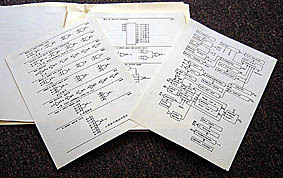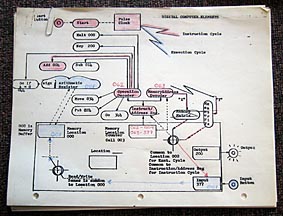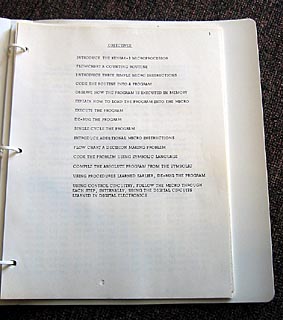|
|
|

The Kenbak 1 - The first Personal Computer.
The Collection of 7 Kenbak-1s in the Computer Museum of Nova Scotia
Update August 2005!
The Collection.
The Computer Museum of Nova Scotia hosts the biggest collection of Kenbak computers and related items in the world. Please explore this website and enjoy the information about the super rare Kenbak-1 computer line.

Kenbak-1 history.
Very little is generally known about the very first Personal Computer, the Kenbak-1. We try to change this with this webpage. The Kenbak-1 was introduced in the September 1971 Issue of the Scientific American Magazine. Here the Kenbak Corporation offered their Kenbak-1 for sale for US$750. The Kenbak-1 was designed by John Blankenbaker. The Kenbak Corporation closed its doors in 1973 - two years before MITS came out with the Altair 8800 - and sold only 40 computers mainly to schools and colleges. This number alone makes the Kenbak-1 one of the rarest - if not the rarest - of all commercially available personal computers. Naturally a lot of the 40 originally sold computers got lost and destroyed over the years. Today - 2003 - the First Computer Museum of Nova Scotia Soc. has knowledge of 10 or 11 Kenbak-1 computers left in existence. This number is even lower then the super rare Apple 1.
What's with the CTI Labels on some of the Kenbaks?
Why are there 3 of the 7 Kenbaks the C.T.I. Education Products, INC. Label and not "Kenbak-1"? Well C.T.I. was the first sales agent for the Kenbak-1. Blankenbaker sent all the pieces and parts to CTI. CTI assembled the computers and put their logo on the front. They renamed the machine H-5050. As far as I know CTI bought 8 of the 40 Kenbak-1s. The Computer Museum has 7 of those 8.
Kenbak-1 pictures.
We own 7 Kenbak-1 computers. We think it is the biggest Kenbak computer collection anywhere. Here are pictures of the 7 machines in detail. Please click on the machine you want to explore. Every Kenbak is different, so make sure you look at all of them.
| Kenbak-1 #1 | |
| Kenbak-1 #2 | |
| Kenbak-1 #3 | |
| Kenbak-1 #4 | |
| Kenbak-1 #5 | |
| Kenbak-1 #6 | |
| Kenbak-1 #7 | |
Kenbak-1 technical data.
The following information was kindly provided by Sellam Ismail from the Vintage Computer Festival:
The Kenbak-1 didn't use a microprocessor. Blankenbaker designed the machine on a single board with TTL-chips. The machine had 256bytes of ram. Here is how the developer John Blankenbaker describes the Kenbak-1:
Instruction cycle is 1us (1Mhz clock speed
roughly)
8-bit word
Serial architecture
It had two 1000 bit MOS shift registers (2000 bit total memory capacity)
Adding two numbers would have taken a "few milliseconds"
It had a "generous set of copcodes" with 4 addressing modes but
no
interrupts. It was a true von Neumann (stored-program) architecture.
All registers are stored in main memory (A, B, Index, Program Counter,
I/O). An interesting feature was that values could be stored in the
Program Counter (though he points out that this is NOT how jumps were
implemented...there was a jump operation). Also, the registers were
stored in memory, which contributed to its slowness, but this allowed
registers to be treated as operands. For instance, to clear A, you would
subtract it from itself.
The largest program Blankenbaker ever wrote on it was a "3D tic-tac-toe
on
4x4x4 board". He says, "It didn't have enough memory to recognize
that
you had won" (when the game was done you had to recognize that on your
own). He continues, "It took up every last bit of every last byte"
of
memory.
How many Kenbak-1s are still in existence?
Here are all the Kenbaks known to exist:
6 Kenbaks are here in the
Computer Museum of Nova Scotia
1 Kenbak belongs to Vinal Applebee of the Maine
Computermuseum
1 Kenbak is at the Computer History Museum in California
1 Kenbak belongs to Mr. Robert Nielsen Sr., South Carolina. This is the
gentleman we aquired the Kenbaks from. Read his amazing writeup about the Kenbaks
and their history here.
2 Kenbaks still belong to John Blankenbaker - the
Kenbak's father - I learned that the Prototype Kenbak is still in existence!!
John also owns another machine. But he told me it's incomplete.
1 Kenbak belongs to Erik Klein. Go to his great webpage
here
1 Kenbak sold on recently on Ebay - as of August 2005 - to an unkown
collector.
1 Kenbak belongs to a person in Tennessee that wants to remain annonymus
That brings the number of Kenbaks still in existence to: 14!
Kenbak-1 "paperwork" and training films.
We own the original schematics for the Kenbak computers,
the original Student Laboratory Manual from CTI, a sales flyer from CTI.
Really neat are the original training films that show the programing of the
Kenbak.
| Scientific American ad - September 1971 | |
| Original CTI - Kenbak information broshure | |
| Systems Trainer Manual Cover |
|
| Systems Trainer Manual excerpt |
|
| Kenbak-1 Schematics |  |
| Kenbak-1 programing chart | 
|
| Kenbak-1 programing course |  |
| Training videos from 1974 | |
If you have any information about the Kenbak-1, please contact us.
This page was last updated on 9/15/2003.